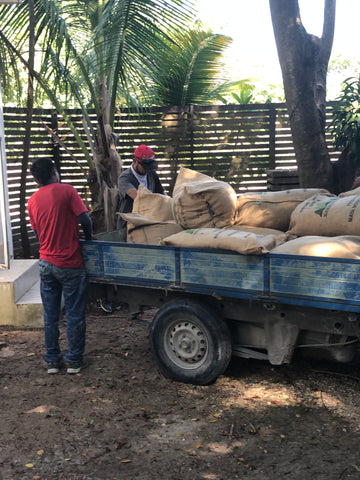The Journey of Mr. Bean

Back in 2013, we were at one of the Toleco Cacao Festivals in Southern Belize where our son, Noah, was given this book by the Toledo Cacao Growers Association (TCGA). In it was a Connect the dots drawing of Mr. Bean (no, not that Mr. Bean), Mr Bean, the cacao bean!
All week, I've been racking my brain, thinking of interesting chocolate-related topics for blogs. Happening upon the pamplet during one of my many COVID-19 induced clearouts, I decided to talk about the journey of a cacao bean from its beginnings to its final destination here on Ambergris Caye, where it's made into delicious chocolate. Here we go...
The Journey of Mr. Bean

Mr. Bean comes from inside one of these pods, which grow on the Theobroma cacao tree (the name given to it by the Swedish botanist Carl Linnaeus in 1753). It’s a small evergreen tree, which grows particularly well in the shade of other larger trees such as the Mahogany that happens to be the national tree of Belize.
Cacao trees grow in a belt 20-degrees north and south of the Equator.
The best cacao in Belize grows in the South where the soil is fertile and the rain plentiful. The tree bears beautiful delicate flowers that sprout directly from the trunk after about three years.
The flower must be propagated, in this case by midges, before it becomes a pod/fruit.
The pods in Belize come in all shapes
 and sizes,
and sizes,

and colors.

When it’s harvest time, usually around November to April in Belize, the pod is manually cut (gently so as not to damage it), from the tree.
Inside the pod, there are approximately forty purple seeds surrounded by a sweet, delicious pulp.

The farmer removes the seeds, throws them into a bucket ,and then moves onto the next tree. The empty pods are left on the forest floor to rot and enrich the soil.
The pods are actually a home for the midges that promote pollination of the flowers and hence the production of more pods.
The farmer then takes the buckets of beans home to the fermentation area.

Fermentation
We buy our beans from a variety of Maya farmers, some of whom ferment their own beans, and also from Maya Mountain Cacao who buy wet beans and specialize in the fermenting and drying process . The wet beans are put into a wooden box, covered with banana leaves or sacks, and left to ferment for six or seven day days. They have to be turned every couple of days.
For our Mr. Bean, it’s a bit like a sauna, it gets pretty hot in there, reaching temperatures of up to 118 degrees Fahrenheit. Fermentation has a huge impact on the flavor of Mr. Bean and hence our chocolate.
Drying
Once the beans are perfectly fermented, they are spread out on drying racks to sun dry. This is a very important step; too much sun and the dry beans break when shipping; too damp and mold might grow and affect our flavors.

Mr. Bean and his friends are dried and then bagged up.
During the season, it's usual for us to visit both the farmers and Maya Mountain every couple of months, in order to check beans and also because we love it down there. It is a beautiful part of Belize.
Last year, we purchased approximately five tonnes of beans.
This year, not so much!
Once the beans are bagged, we contact our friend Bruno, who organizes for the sacks of beans to be transported by truck to the port in Belize City. We normally order about fifteen sacks at a time (one sack is 120lbs).
Once at the port, they are loaded onto a barge and transported to Ambergris Caye.
Mr. Bean has one more journey to take and that’s from the barge depot, by truck again, to our factory on the south end of the island.

Mr. Bean and his friends have arrived at their destination.
The End
(All photos of pods and farms were taken by me during our various trips to the cacao farms over the past twelve years)